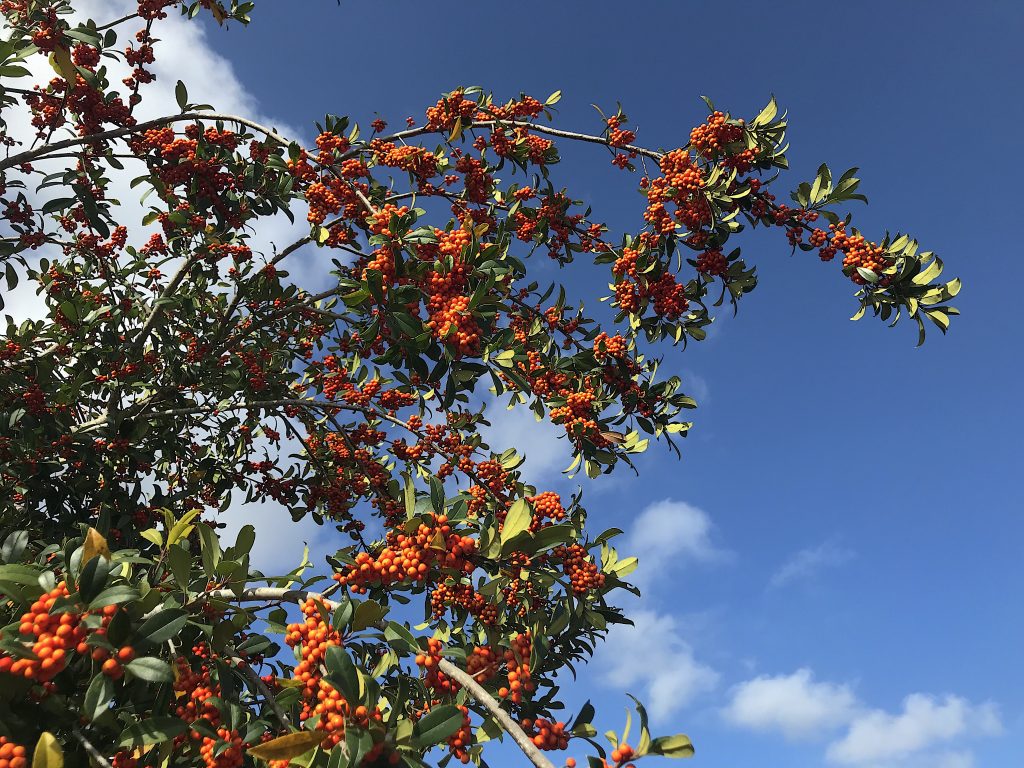
Pyrachantha, the firethorn, is planted for beauty not consumption. Photo by Green Deane
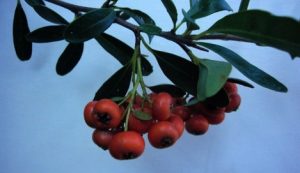
Firethorn with seeds removed are edible. Photo by Green Deane
Pyracantha, Firethorns, are hard to ignore when in fruit. From a forager’s point of view they are carefully useable. Pyracantha are related to apples and like apples have some cyanide in their seeds (so we don’t eat the seeds.) The ripe fruit have a mealy texture and an apple-like taste. The most common use is to make a sauce or syrup. (You strain the seeds out either before or after cooking.) A native of southern Europe to the Caucasus Mountains, it’s been under cultivation in the “West” for close to 400 years. The fruit is very high in ascorbic acid, that is, vitamin C. You can read about the species here.
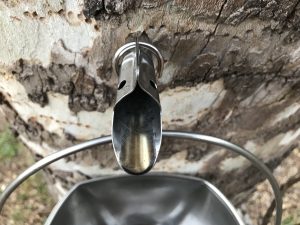
Sycamore sap flows like Maple sap. Photo by Green Deane
Sycamores are condemned because every year they drop a huge amount of large leaves. The wood itself is non-toxic and can be used for skewering hot dogs or making wooden forks or bowls or for smoking edibles. You can also collect and reduce the sap, but it takes a lot. Maple sap has just enough sweetness for one to taste straight from the tree. Sycamore sap does not. But if you can collect enough to boil down it tastes like butter scotch. That said you need far more Sycamore sap to get a syrup than maple sap. Actually several species can be tapped: Birch, Hickory and Ash. In fact Birch syrup is a commercial product and tastes similar to molasses.
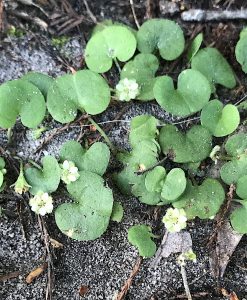
Pony Foot is an under unappreciated edible. Photo by Green Deane
Pony Foot is easy to overlook. It’s a small, kidney-shaped ground cover and can taste mild to slightly bitter. It spreads by underground runners and was once intentionally planted as a ground cover for shady areas. Herbalists call them a “liver tonic.” I happended to notice some this week blossoming. They have a five-petal blossom with five sepals. I’m not sure why the plants were called Dichrondra which means two hearts. Reni- or Nephri— (meaning kidney shaped) would have been far better. Its leaves do alternate but they are far more kidney-shaped than heart-shaped. They are also have a slightly off-side funnel shape (a basal notch.) Usually dime-size I have seen them more than an inch across. A 1905 report suggested that Pony Foot extract with glycerine was good against bacteria associated with diphtheria.
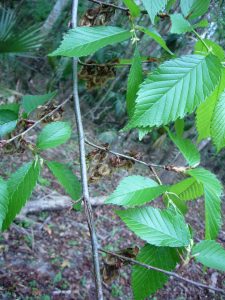
Elm leaves and buds are edible. Photo by Green Deane
This time of year, locally, Basswood and Elm leaves are tender and quite edible right off the tree. The inner back of both are edible as well and buds et cetera. I had experience with both while growing up. When the elm grows it twists whereas white pine and ash grow straight. This means much if you have to size them by hand. When you hit a piece of ash or pine with an ax it cleaves easily into two pieces (presuming you know how to swing an ax.) Elm, however, like hatmatack, twists as it grow. It does not cleave: It grabs the ax and does not let go. You have to have wedges and sledge hammers to size up elm. One of my jobs as a teenager in a house with two wood stoves and free elm was to size up the wood. My other job was round-the-clock care of five horses. Basswood — also called the linden tree, is the basis of one memory I have of my step father. You can read about it here. Basswood was used to make pipe stems (after we made the pipe bowl from applewood.) I still have one of the pipe bowls we made some 60 years ago.
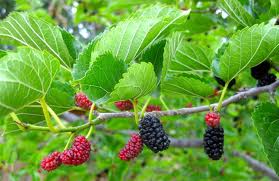
Mulberries are pink now turning dark purple. Photo by Green Deane
A few newsletters ago it was mentioned the Mulberries were in blossom. This week we ate our first Mulberries of the season. Looking like over-grown blackberries but completely sweet you eat all of them except the short stem… or you can eat that, too. In fact, I just nibble them off the tree. Like many fruit trees they are highly seasonal, producing for perhaps a month though with a bit of travel you can extend the season. You have to work with its schedule not yours. The Mulberry is also considered a trash tree locally because it drops a lot of purple-black berries on oh-so-clean sidewalks and manicured lawns. In fact, they’ve even bred a fruitless kind… have your mulberry but don’t eat it, too… Don’t forget the young leaves are edible cooked. To read more about the Mulberry go here. To see my video on Mulberries, click here.
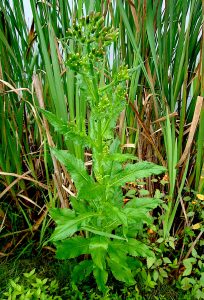
Burnweed/Fireweed in blossom in front of cattails. Photo by Green Deane
Burnweed/fireweed has a flavor most chefs love. With an impossible scientific name and strong aroma Burnweed is often overlooked by the foraging community. Conversely the aroma is also a good identifying characteristic. As with several things in life tastes vary and many people enjoy the Burnweed raw or cooked, several do not. Closely related to Red Flowered Ragweed, the Burnweed locally favors the late winter or early spring. Currently you can find Burnweed from a few inches high to a couple of feet. While they do not grow in colonies often several will grow near each other. Soon the older ones will put on yellow blossoms that barely open, another identifying characteristic. Of course in greens young and tender is usually preferable and this is particularly true with the Burnweed which grows rank as it ages. To read about Burnweed go here.
Pawpaws (or papaws per Random House) can be among the most difficult wild fruits to find. They like to hide and woodland creatures like to eat them making it difficult for us. The easiest way to locate pawpaws is find them when they’re blossoming and they are blossoming locally now.
The most common place to spy pawpaws is and around pastures. Grazing livestock don’t eat the plants, blossoms or fruit. Look for bushy shrubs around five feet tall with magnolia-like cream-colored blossoms, or much smaller foot-size shrubs with dark ruby blossoms.
I can remember the first time I found a pawpaw. It was along a walking trail in Longwood, FL. At first I thought I had found a lumpy green pear but it was an unripe pawpaw. Interestingly pawpaws change greatly from hot Florida to the Smoky Mountain area. There, pawpaws are medium trees.
There are two caveats: A chemical in pawpaws is still used to control head lice. And some people have a severe allergic reaction when eating the fruit which is the prime reason they have not become a commercial fruit. That is, it’s not a significant health threat to the population at large but it is enough to give the lawyers fits. To read more about pawpaws, or papaws, click here.

Classes are held rain or shine or cold. (Hurricanes are an exception.) Photo by Kelly Fagan.
Foraging Classes: With unexpected good timing we will be in southwest Florida Saturday when a cold front is to pass through and in east Orlando Sunday.
Saturday March 12th, Bayshore Live Oak Park, Bayshore Drive. Port Charlotte. 9 a.m. to noon. Meet at the parking lot at Ganyard and Bayshore
Sunday March 13th, Blanchard Park, 10501 Jay Blanchard Trail, Orlando, FL., 9 a.m. to noon. Meet next to the tennis courts.
Saturday March 19th, Boulware Springs Park, 3420 SE 15th St., Gainesville, FL, 9 a.m. to noon. Meet at the pavilion.
Sunday March 20th, Colby-Alderman Park: 1099 Massachusetts Street, Cassadaga. Fla. 9 a.m. to noon. Meet at the bathrooms.
Saturday March 26th, George LeStrange Preserve, 4911 Ralls Road, Fort Pierce, FL, 34981. 9 a.m. to noon. This location does not have official bathrooms or drinking water.
Sunday March 27th, Mead Garden: 1500 S. Denning Dr., Winter Park, FL 32789. Meet at the bathrooms. 9 a.m. to noon.
Saturday/Sunday May 7th & 8th, Honea Path, South Carolina, classes at 9 a.m. and 1 p.m. each day.
For more information, to pre-pay or sign up go here

You get the USB, not the key.
My nine-DVD set of 135 videos has been phased out and replaced by 171-videos on a 128-GB USB, see left. The USB videos are the same videos I have on You Tube. Some people like to have their own copy especially if social order falters. The USB videos have to be copied to your computer to play. If you want to order the USB go to the DVD/USB order button on the top right of this page or click here. That will take you to an order form. Or you can make a $99 donation, which tells me it is for the USB (include a snail-mail address.) I’d like to thank all of you who ordered the DVD set over the years which required me to burn over 5,000 DVDs individually. I had to stop making them as few programs now will read the ISO files to copy them. Burning a set also took about three hours.

Green Deane Forum
Want to identify a plant? Perhaps you’re looking for a foraging reference? You might have a UFO, an Unidentified Flowering Object, you want identified. On the Green Deane Forum we — including Green Deane and others from around the world — chat about foraging all year. And it’s not just about warm-weather plants or just North American flora. Many nations share common weeds so there’s a lot to talk about. There’s also more than weeds. The reference section has information for foraging around the world. There are also articles on food preservation, and forgotten skills from making bows to fermenting food. Recent topics include: Stale Bread and Cod Liver Oil, Killing Bugs with Tobacco Plugs, Eating weeds: Is it safe? Have they mutated? Not the Eastern Red Bug but the Pink Tabebuia, African Tulip Tree, Asparagus densiflorus, Green Deane’s Book… You can join the forum by clicking on the button on the upper right hand side of this page.
This is my weekly newsletter #498. If you want to subscribe to this free newsletter you can find the sign-up form in the menu at the top of the page. My website, EatTheWeeds.com, which is data secure, has over 1500 plants on it in some 428 articles. I wrote every one myself, no cut and paste.
To donate to the Green Deane Newsletter click here.

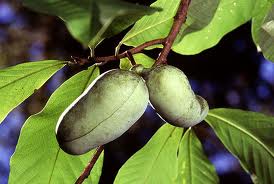

1. Have made Pyracantha Wine.
2. Best is Mulberry Wine! My trees give 40 to 60 gallons of wine each year.!!!
3. Also make Mulberry jam/jelly, and cobbler.
4. Any chance of using this site as a plant exchange? No $ except postage paid by each. Bare root plants in the mail. The Insulin plant has cured two neighbors of Adult Onset Diabetes. Stone breaker Plant has broken up MY Gallstones.
5. Would this be ok? Any interest?